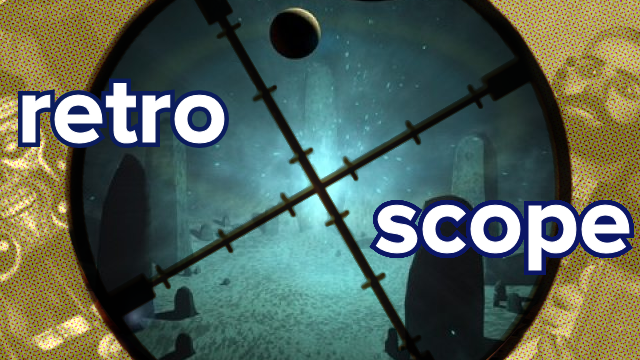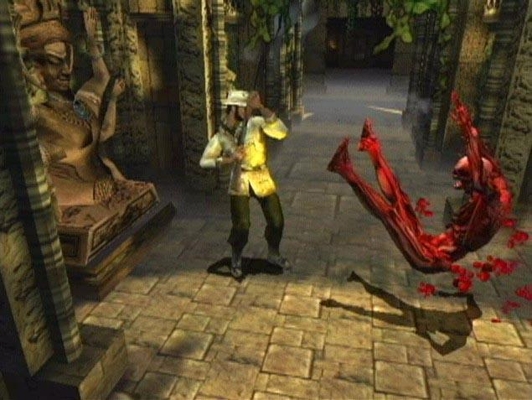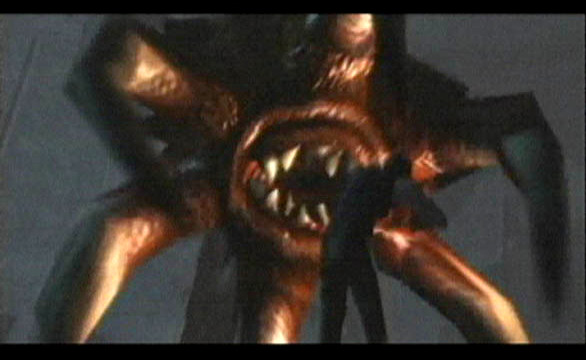
Long I stood there,
Wondering…
Fearing..
Doubting…”
These words from Edgar Allen Poe have a special place in the hearts and minds of some gamers; instead of reminding us of Poe’s “The Raven,” they bring us back to another artistic work of equal brilliance, Silicon Knight’s Eternal Darkness: Sanity’s Requiem. When the game launched it was praised by critics; however, its biggest accomplishment is not just the fact that it has earned a legion of hardcore fans, but that this group remains so passionate over a decade later. Though when I take the time to look back at the game, it is really easy to see why.
When Eternal Darkness launched back in the summer of 2002 it quickly became my obsession for the next several months. What was kind of strange about it was that I really wasn’t that interested in the game leading up to its launch; my older brother was excited for the game and I really had very little interest in the horror genre in general, regardless of medium. So at the beginning we would take turns playing but as we progressed I slowly took over the responsibility for playing, not wanting to wait around for my brother to be free to experience the game. By the time we reached the second play-through, the game effectively became mine because I was hooked.

Earlier that year I had made another attempt to delve into survival horror with the Resident Evil remake, and while the great graphics were used to create a compelling atmosphere, the controls remained obtrusive, the dialogue was still laughable, and the story was actually rather bland, lacking the needlessly twisted insanity found in the later entries. Eternal Darkness also used the GameCube’s processing power to build a variety of great, atmospheric environments, but Silicon Knights put just as much effort into telling a compelling story and crafting an innovative control scheme with combat mechanics that I would dare argue have yet to be surpassed within the genre. Instead of just trying to come up with some creepy ideas and environments, Silicon Knights made sure to build a truly great gameplay experience around them.
I could continue to breakdown all the great elements within Eternal Darkness, but that would be redundant as I have already gone into great detail about how much I love this game not just once, but twice. Instead, I have some new ideas I’d like to add to the discussion!
You see, with the announcement of Shadow of the Eternals I’ve found myself thinking about the horror genre and the way in which it has developed. It seems like survival horror games have divided into two directions, either becoming more action focused or drastically reducing the amount of action to the point where some games have completely dropped it. Both the Resident Evil and Dead Space series have empowered players with more and more combat skills with each passing entry resulting in less overall tension. On the other hand, there are titles like Amnesia: The Dark Descent, and Slender that focus entirely on building creepy environments filled with horrifying enemies while leaving the player powerless to defend themselves, and while the result is extremely terrifying it ultimately limits the appeal to a very dedicated group of scare seekers. I think Eternal Darkness still stands out all these years later because Silicon Knights managed to strike the perfect balance between truly enjoyable gameplay and genuine scares.

The key to this is inspiration Eternal Darkness draws from Lovercraftian horror, specifically the Cthulhu mythos. The key to this style of horror is the very reasonable assumption that bearing witness to the acts of horrible violence committed by grotesque, otherworldly monsters would seriously damage the psyche of your average person. Eternal Darkness is the first survival horror game I can think of that actually had the playable characters affected by the events around them; this is, of course, primarily accomplished through the game’s oft celebrated Sanity Effects that had characters hallucinating everything from their own bloody demise to fourth wall shattering technical problems. Now let’s look back at Resident Evil; Chris and Jill see their colleagues get brutally murdered by horrible monstrosities and do battle with reanimated corpses but there really isn’t any sense of impact on them as characters. The likes of Silent Hill and Dead Space do incorporate psychological elements into the story and setting, but Eternal Darkness includes it as a gameplay element that works in real time and is highly randomized to prevent the scares from becoming repetitive on later play-throughs, which is something the game makes very worthwhile.
This approach to horror allowed Silicon Knights to craft enjoyable and empowering combat mechanics without breaking the tensions, because the scares are not a product of each playable character’s physical weakness, but rather their psychological vulnerability. However, the developers even added a twist to this by giving each player unique health, sanity, and magick attributes, which means you might be playing one character with strong mental fortitude but little combat skill in one chapter before moving onto another who is an absolute beast in a fight but quickly succumbs to effects of his or her draining sanity. This is not only great for the game’s overall sense of tension, it is also a great gameplay feature that, when incorporated with weapons that span 2000 years of world history, also adds some great variety to combat and exploration.
Taking all these factors into consideration, it is pretty easy to see just why this game is so celebrated; even after going on and on about why Eternal Darkness is so spectacular, I am still thinking of new ways in which the game innovated and set itself apart from other titles in the genre. Eternal Darkness wasn’t just introducing creative ideas that were ahead of its time, it was coming up with solutions to problems that are facing the genre today. Part of me almost wants to say that nothing more really needs to be said about Eternal Darkness and its place in gaming history, but the fact that we are still talking about it and realizing ways in which it has innovated and changed gaming for the better suggests that there is still fruit waiting to be picked from this tree. So let us continue to show the reverence this game deserves, not just for providing an awesome gameplay experience but continuing to inspire such discussion and devotion from gamers.




 ShareThis
ShareThis







This is a great game. I wish I stil had it. The time periods involving the church used to freak me out the most!
It’s funny. This game certainly has flaws, and often feels more like something that was designed for the less powerful N64 rather than a real GameCube title… but the strengths of story and atmosphere outweigh any problems so easily! A true classic.
Of course, it _did_ start out as an N64 game, but it never felt like that to me. The N64 was a great machine, but it never had very detailed textures, and hardly anything ran at 60fps. Let alone the GameCube’s higher resolution, progressive-scan, and widescreen support, all of which Eternal Darkness sported like a champ. The game still looks good today, in my opinion.
But, you’re not the first to say how ED felt N64ish. I think you might be misremembering the N64 a bit, but I won’t go so far as to say you’re wrong. :^)
Eternal Darkness didn’t look like the previous generation. It certainly could’ve been prettier in some places, but most of the rough edges were hidden with good art design. Overall I think the Silicon Knights did a great job making Eternal Darkness look great.
It was more about the stilted combat and movement that made me think N64. Some design decisions were awesome – targetting different body parts, for example – but never fleshed out enough to really matter. It’s those sort of design issues that gave away it’s origin as a N64 game in my opinion.
(Again: this doesn’t take anything away from it’s status as a classic title worth playing.)
I valued Sanity over Health
“Some design decisions were awesome – targeting different body parts, for example – but never fleshed out enough to really matter.”
The body part targeting mattered greatly to me when I played. I remember always trying to go for the head in order to kill the enemies quickly before they could drain my Sanity meter. However, that didn’t always work out as well as I expected it to, especially when there were multiple enemies around, then it helped more to “disarm” them so I they couldn’t attack my health while I tried to finish them off. I was super weary about conserving my ammo, and I was glad to always have a melee weapon to fall back on.
Just talking about makes me want to go back and play it again. The only thing more that I wanted from this game was co-op multiplayer so the people watching me could play too. That’s what made me get Obscure: The Aftermath for the Wii.